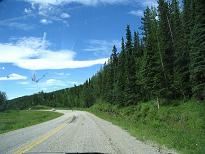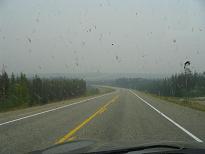Mawlers’ Big Adventure ’04:
Metaphysical Musings
What is The Road?
|
When you drive a historic route, what makes that route historic? In the case of the Alaska Highway, many people know the history and that is part of what draws them to the route, much the same with Route 66. When you drive a historic route, you are trying to capture some of the adventure and the sense of place that comes with the specific route, but do you ever really get that? Is a historic route ever really what we want it to be? We think of the Alaska Highway as the work of intrepid soldiers from the US Army, pushing their way through uncharted territories of the Canadian back country. This is, in fact, the origin of the road carrying the same name, but you would be hard-pressed to recognize much of that road today. As a road takes wear, you need to maintain it. There will be potholes to fill, washouts to repair, bridges to rebuild, etc. This is part of being in the world. What happens when you discover that the road bed is on a marshy bit and would really be better a mile to the west? What about the need to address increasing traffic by widening the road, taking out dangerous curves, putting in stop lights, or simply paving it? Once you take a gravel track through the tundra, move it from one river bank to another, straighten it, widen it, pave it, and have it skip small towns, is it the same road anymore?
Today, the road is paved (mostly) the whole way and wide enough in most places that you can almost pass without getting in the opposing lane. The shoulders are wide enough to pull off safely, which is a good thing when tourists stop to take pictures of bear, but clearly not our classic image of the Alaska Highway. In some places, the highway acts like freeways in the lower 48 of the US, by going around a lot of little hamlets like Champagne, Yukon. For much of the trip, I entertained myself by looking for the old road bed. In some places, you can look to the right and left to see the old road bed from various periods of time when it was more convenient to have the road somewhere else. The most typical change has been to take out the curves. Curvy roads are slow, dangerous, and make passing difficult. So the life of the highway has been one of progressive straightening. Basically, the Alaska Highway is significantly shorter now than it was originally. In fact, very few people ever drove on the storied first Alaska Highway and it has been under a process of constant change ever since its inception.
In the very beginning, it was little more than a mud track with primitive log bridges over the creeks. The very next season, a US civilian agency undertook rebuilding the road as an all-weather road. That agency changed the location of the road in many locations, built new bridges, and widened many parts. After the US finally went back to the US, Canadian firms were hired to improve the road. Today, the provincial and territorial governments continue to make changes. The Highway is the major transportation route through the area. Just like the gold rush, it remade the economy of the Yukon. Whitehorse became the territorial capital, at least in part, because of the road. The original intent of the road was to carry war materiel and the current value of the road for hauling freight cannot be overstated, despite the heavy tourist use. Perhaps the essence of the road is not the road bed itself, but the area through which it winds, the purposes to which it is put, and the ghosts of the people who drove it before you. Still, watching the ghost of the road itself snake through the mountains to your left and right, you can’t help feeling a bit nostalgic for that slower, more dangerous, and infinitely more picturesque road of yore. Or perhaps just last season. |
|||
|
|
|||
|
The previous installment: |
|||
Back to Great White North Trip main page
Back to Mawler Home
All materials © 2004 Lea Ann Mawler & Stuart Mawler

